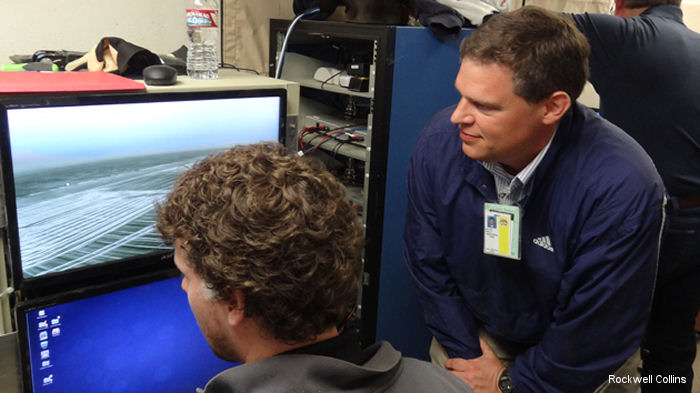
Rockwell Collins, September 22, 2015 - CEDAR RAPIDS, Iowa - Just imagine that you’re a Black Hawk helicopter pilot trying to land your aircraft on rough terrain in blinding brownout or whiteout conditions.
Unfortunately, this is what military helicopter pilots must do on an all-too frequent basis.
Engineers at Rockwell Collins, an industry leader in developing synthetic vision solutions for aircraft, continue to advance critical technologies necessary to solve the problem of flight in Degraded Visual Environments (DVE) for the company’s customers.
Brad Walker, principal system engineer from Rockwell Collins’ Advanced Technology Center, led test activities at the Army’s Yuma Proving Grounds (YPG) where demonstrations of the company’s most recent software improvements were performed. Leading an industry team of partner companies that provided over five different sensor types, Walker and his colleagues successfully demonstrated the company’s sensor agnostic Synthetic Vision Avionics Backbone (SVAB) solution, which efficiently fuses, in real time, multiple DVE sensor types with our high resolution Tactical Synthetic Vision System.
“This testing showed that we can efficiently fuse 2D imaging sensors and LIDAR (Laser Imaging Detection And Ranging), two prevalent sensing technologies being considered today, into our Tactical Synthetic Vision System,” said Walker. “This is important because both systems offer advantages and disadvantages in terms of obscurant penetration and enhanced situational awareness information for the pilot.”
Ryan Olson, senior systems engineer from Rockwell Collins’ Airborne Solutions Engineering was a key part of the engineering team that performed integration and test of the new capabilities. Following the testing Olson stated, “Our testing at the Army’s YPG dust environment validated a number of advancements in our sensor fusion algorithms that when combined with our earlier work in radar data fusion allows us to deliver higher performance solutions to our military customers, while balancing affordability in a complete system solution.”
The testing was part of Rockwell Collins’ continuing efforts to develop a scalable, sensor agnostic Synthetic Vision Avionics Backbone (SVAB) system that will enable helicopter pilots to safely operate in all type of DVE. The SVAB development for military rotary wing aircraft leverages enhancements to our proven Synthetic Vision System solutions currently fielded on commercial fixed and rotary wing aircraft.
Additional flight tests are planned for later this year, when Rockwell Collins engineers will team with the University of Iowa’s Operator Performance Laboratory to conduct detailed flight demonstrations and testing of our SVAB’s sensor fusion capabilities for helicopters.
Unfortunately, this is what military helicopter pilots must do on an all-too frequent basis.
Engineers at Rockwell Collins, an industry leader in developing synthetic vision solutions for aircraft, continue to advance critical technologies necessary to solve the problem of flight in Degraded Visual Environments (DVE) for the company’s customers.
Brad Walker, principal system engineer from Rockwell Collins’ Advanced Technology Center, led test activities at the Army’s Yuma Proving Grounds (YPG) where demonstrations of the company’s most recent software improvements were performed. Leading an industry team of partner companies that provided over five different sensor types, Walker and his colleagues successfully demonstrated the company’s sensor agnostic Synthetic Vision Avionics Backbone (SVAB) solution, which efficiently fuses, in real time, multiple DVE sensor types with our high resolution Tactical Synthetic Vision System.
“This testing showed that we can efficiently fuse 2D imaging sensors and LIDAR (Laser Imaging Detection And Ranging), two prevalent sensing technologies being considered today, into our Tactical Synthetic Vision System,” said Walker. “This is important because both systems offer advantages and disadvantages in terms of obscurant penetration and enhanced situational awareness information for the pilot.”
Ryan Olson, senior systems engineer from Rockwell Collins’ Airborne Solutions Engineering was a key part of the engineering team that performed integration and test of the new capabilities. Following the testing Olson stated, “Our testing at the Army’s YPG dust environment validated a number of advancements in our sensor fusion algorithms that when combined with our earlier work in radar data fusion allows us to deliver higher performance solutions to our military customers, while balancing affordability in a complete system solution.”
The testing was part of Rockwell Collins’ continuing efforts to develop a scalable, sensor agnostic Synthetic Vision Avionics Backbone (SVAB) system that will enable helicopter pilots to safely operate in all type of DVE. The SVAB development for military rotary wing aircraft leverages enhancements to our proven Synthetic Vision System solutions currently fielded on commercial fixed and rotary wing aircraft.
Additional flight tests are planned for later this year, when Rockwell Collins engineers will team with the University of Iowa’s Operator Performance Laboratory to conduct detailed flight demonstrations and testing of our SVAB’s sensor fusion capabilities for helicopters.
See also |




